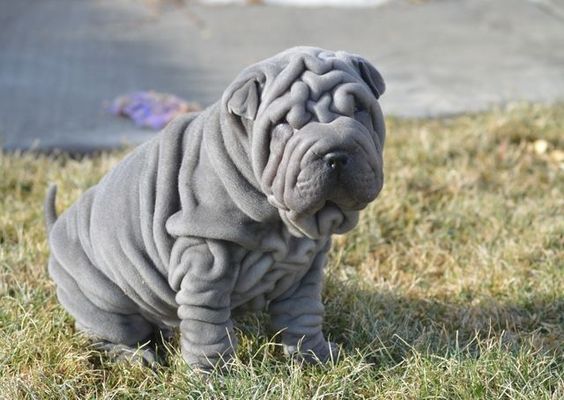At first glance, you might think that the Shar Pei is clumsy, clumsy, and looks like a hippo. In fact, representatives of the breed are not slow, they are very fond of outdoor games and long walks.
As for the resemblance to a hippo, the Sharpei really resembles this animal because of its folded skin and peculiar head shape. The dog’s gloomy appearance and stern disposition make it an excellent guardian. It will be difficult for novice dog owners to cope with the wayward nature of the Shar Pei, so this breed is suitable for strong-willed people who have experience with dogs.
сontents
History of the breed
Given that the breed is very ancient, the beginning, peculiarities of history and all the details of its formation to the smallest detail are not known to anyone. The concealment of many facts about the Shar Pei’s past was facilitated by the act committed by Qin Shi Huang for no apparent reason. This great emperor of China destroyed all the books that kept records of the breed and reflected historical events concerning the Shar Pei. To this day, no explanation has been found for this act.
The Shar Pei’s homeland is China. For centuries, this species of animal lived exclusively on the coast of the South China Sea and in southern China. It is reliably known that these dogs appeared more than 3000 years ago. Only four species can boast of such a respectable age, and they are called the descendants of the first dog on the globe.
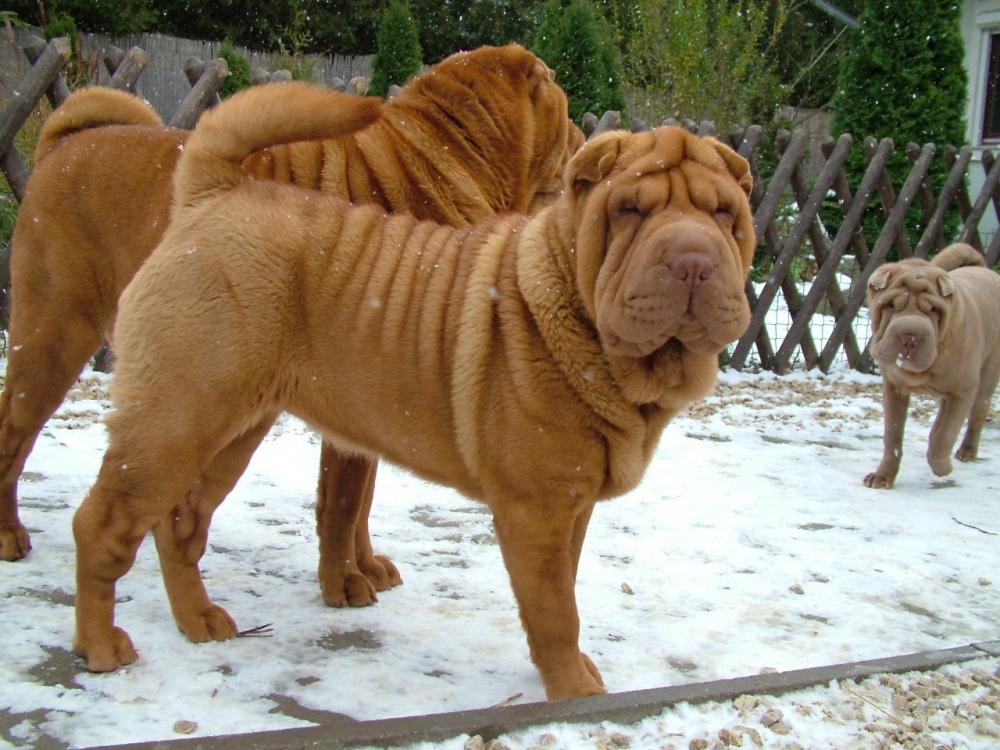
According to the information that has survived and reached the present day, it is clear that the history of the breed is full of amazing facts. The peak of popularity in the ancient history of the Sharpei was in the 3rd-2nd centuries BC, to be precise, in the thirties of the last century. It was during this period that representatives of the breed lived in almost every Chinese family. It made no difference whether they were poor or noble, rich nobles. This is not surprising, because it was believed that the wrinkled skin of Sharpeys could ward off evil spirits. During the excavations of ancient Chinese tombs, a large number of clay figures in the form of frowning, one might say, formidable dogs with their skin in numerous folds were discovered.
The Chinese people used this breed for completely different purposes – to protect and graze livestock, to guard homes, as a nanny, and in battles. Until the revolution and civil war that led to the creation of the People’s Republic of China (PRC), these dogs faithfully served people of all social strata.
However, during the years of the so-called “Great Leap Forward”, when the country was gripped by an incredible famine that led to the deaths of more than 40 million people, Shar Peis were practically wiped out. To be more precise, they were simply eaten – people survived as best they could. No matter how barbaric it may seem to us.
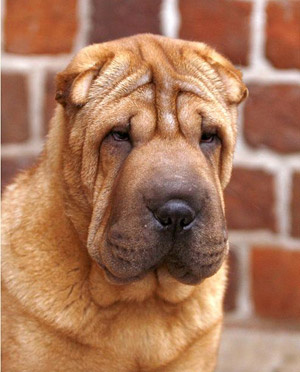
A small number of dogs were saved by being transported to Hong Kong, to the Down-Homes kennel, by an enthusiastic dog breeder, Matgo Low. In 1973, several individuals were shipped to the United States. A year later, the dog owners organized the Chinese Shar-Pei Club of America, and in 1978, the first specialized national show was held. Thanks to activists, work began on restoring the population of these dogs. The breed was on the verge of extinction, as only 8 purebred representatives of the species were found in 5 years. They became the basis of the Shar Pei revival.
The Shar Pei was recognized as the rarest breed and listed in the Red Book. It took more than a decade to restore the number of these dogs.
In 1991, the American Kennel Club officially recognized the breed and gave it the status of a member of the sports group.
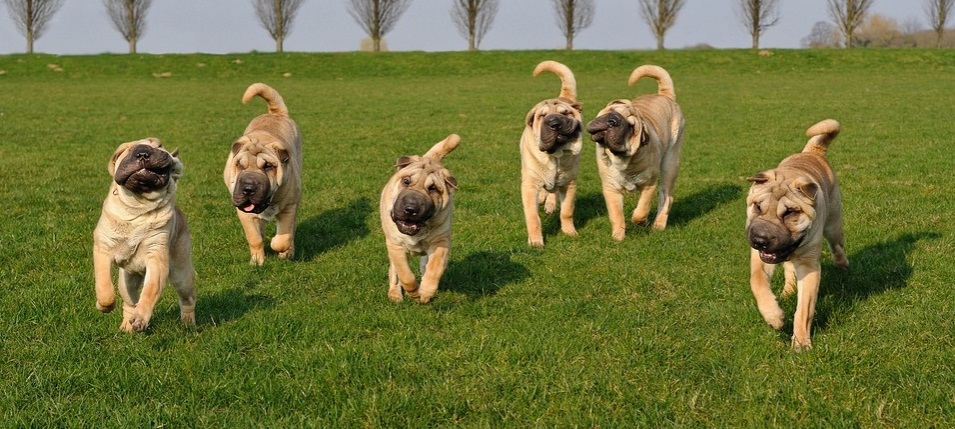
Speaking of the latest news, it is worth noting the interest in Sharpeys on the part of scientists. Geneticists from the University of Washington in Seattle have done serious work and in 2010 announced that the cause of the folds characteristic of the breed is a mutation of the HAS2 gene, which is responsible for the production of an enzyme that is fundamentally important for the formation of skin cells. They suggest that the spontaneous DNA glitch that resulted in the unusually “creased” puppy was noticed and fixed by ancient Chinese breeders.
Another study conducted in 2004 shows that the Shar Pei, along with the Siberian Husky, Afghan Greyhound, and Pekingese, belongs to the so-called first cluster of breeds, meaning that their genotype is most similar to the set of genes of the wild wolf.
Description.
The Shar Pei (or Shapi, Khan’s dog) is the oldest Chinese dog breed with versatile working functions.
In ancient times, it guarded houses, herded cattle, participated in hunting, and destroyed invasions of mongooses that attacked poultry. Nowadays, it is considered a wonderful companion and family friend.
An interesting fact is that the Chinese call the Shar Pei a dog that “licked the sky” and believe that its blue tongue can drive away evil spirits.
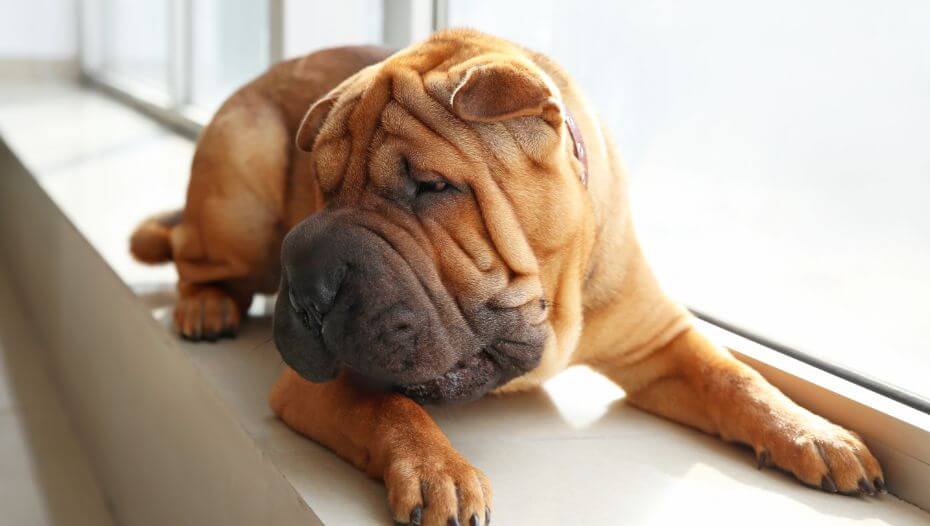
Features of the breed
The Sharpei is a philosopher in the form of a dog. The animal got this nickname for its highly developed mind and ability to think. In China, it is believed that when a dog is engaged in mental work, labyrinths of mental activity appear on its forehead.
Today, there are two varieties of Khan’s dog, differing in individual characteristics of the hair coat, so the IKF is considering dividing the breed into 2 types:
- Chinese. It has a lightweight greyhound coat, up to 1 cm long.
- American. It has a heavier and longer brindle coat 1-2.5 cm, but more than 3 cm.
Key features:
- Activity level. The breed is very energetic in puppyhood. Adults are moderately active.
- Appearance. An intelligent-looking dog of impeccable build with a powerful bone. The coat is mildly rough, but the visibility is good.
- Weight and height. The height at the withers for dogs of both sexes is slightly different. Boys are 46-52 cm tall, girls are slightly shorter – 44-50 cm. The body weight of a male and female dog varies between 20-35 kg.
- Life expectancy. The average life expectancy with good care and attention to the dog’s health by the owner is 9-11 years.
An interesting fact is that according to legend, the Shar Pei used to weigh as much as 80 kg. However, in the process of further breeding, its body became too small, while the skin remained the same size, which is why it forms numerous expressive folds.
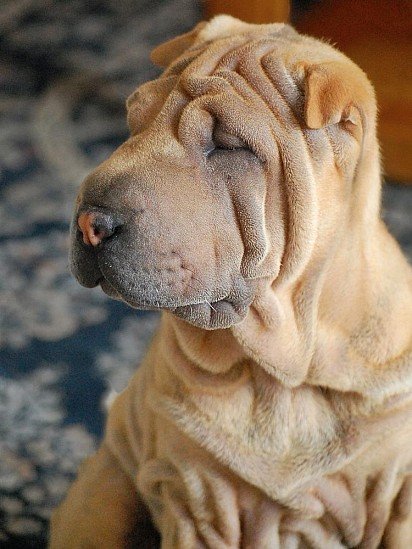
Head. It is broad and flat, with a moderately pronounced stop between the crown and a broad, strong muzzle that does not taper toward the nose. The folds of skin around the forehead and eyes give the dog a gloomy expression, even when it is relaxed.
Ears. The ears of the Shar Pei are very small in relation to the proportions of the dog, triangular in shape and bend forward.
Eyes. They are medium-sized, almond-shaped, and vary in color depending on the color of the Sharpei’s coat.
Mouth. Large teeth, scissor bite. The jaws are powerful. The pigmentation of the gums, lips, and tongue is pronounced: they should be blue-black, although some individuals have a lavender tint.
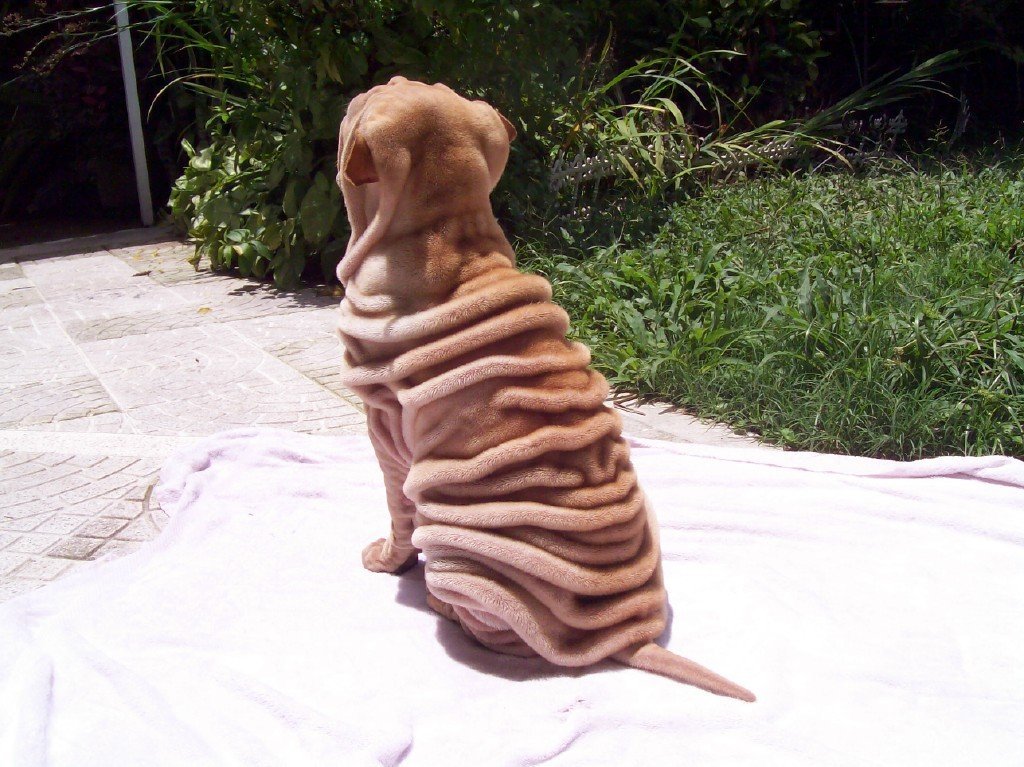
Neck and back. Muscular and lean; some excess skin around the neck is acceptable, although there should be no folds from the ears to the shoulders, possibly on the withers.
Body. The ideal Sharpei should be as long from withers to hocks as it is tall from ground to withers, with a chest half as deep as this measure, giving a pleasing proportion. The ribs are well vaulted.
Fore and hindquarters. Show a moderate angulation of the joints, giving a powerful, athletic appearance and are clearly muscular. Skin folds are undesirable.
Tail. The Sharpei’s tail is thick at the base, where wrinkles are often visible again, and tapers to a thin tip. It can be curled into a tight ring.
Coat. It consists only of the hair shaft, with no soft undercoat. It is short and extremely coarse, resembling bristles to the touch.
Color. Sharpey can be any solid color except white: “red deer” (red, classic), black, chocolate, apricot or cream dilute, blue, isabella, lavender, and others. Spots are not allowed, but darker (along the spine and on the ears) and lighter (tail and back of the thighs) areas of the coat are possible.
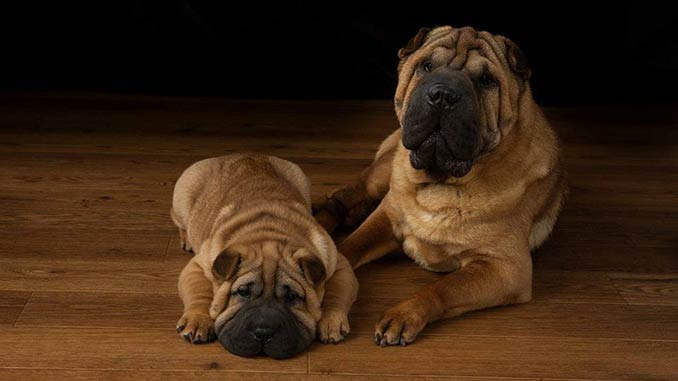
Breed standard.
In ancient times, the Sharpei’s ancestors were fighting dogs. The main distinguishing features of the breed are a blue-black tongue and numerous skin folds. It is not surprising that the descendants of fighting dogs have a strong build and are medium in size. The appearance of a square, compact body shape is created. The weight of adults is about 20 kg, height at the withers is 44-51 cm. Dogs are superior in both weight and height to bitches.
The head is relatively large, the ears are small, triangular. The tips of the ears are rounded, directed to the eyes and pressed to the head. The eyes are dark, small. The muzzle is wide; any hint of narrowing is not allowed. The nose is wide and large. The tongue, depending on the color of the coat, can be: blue with pink spots, blue-black, purple, lavender, blue.
The croup is straight, the back is short. Skin folds are welcome on the withers, at the base of the tail. The legs are straight, muscular, parallel, and of medium size. Another feature of the Sharpei is its high-set tail (the anus is not covered at all). It is in the form of a ring or curved over the back.
The skin is unique, hypertrophied and folded. Sharpeys have an unusual coat; it is stiff, short, and sticks out on the body. The hair is bristly without an undercoat. Representatives of the breed differ in the type of coat:
- Brush
- “Bear hair”
- Horses.
Two types of colors are allowed:
- Basic color with black pigment of varying intensity: fawn, black, sable, mahogany, isabella, blue, cream.
- Dilute group (except for black): isabella, chocolate, apricot, sable, cream, red, mauve.
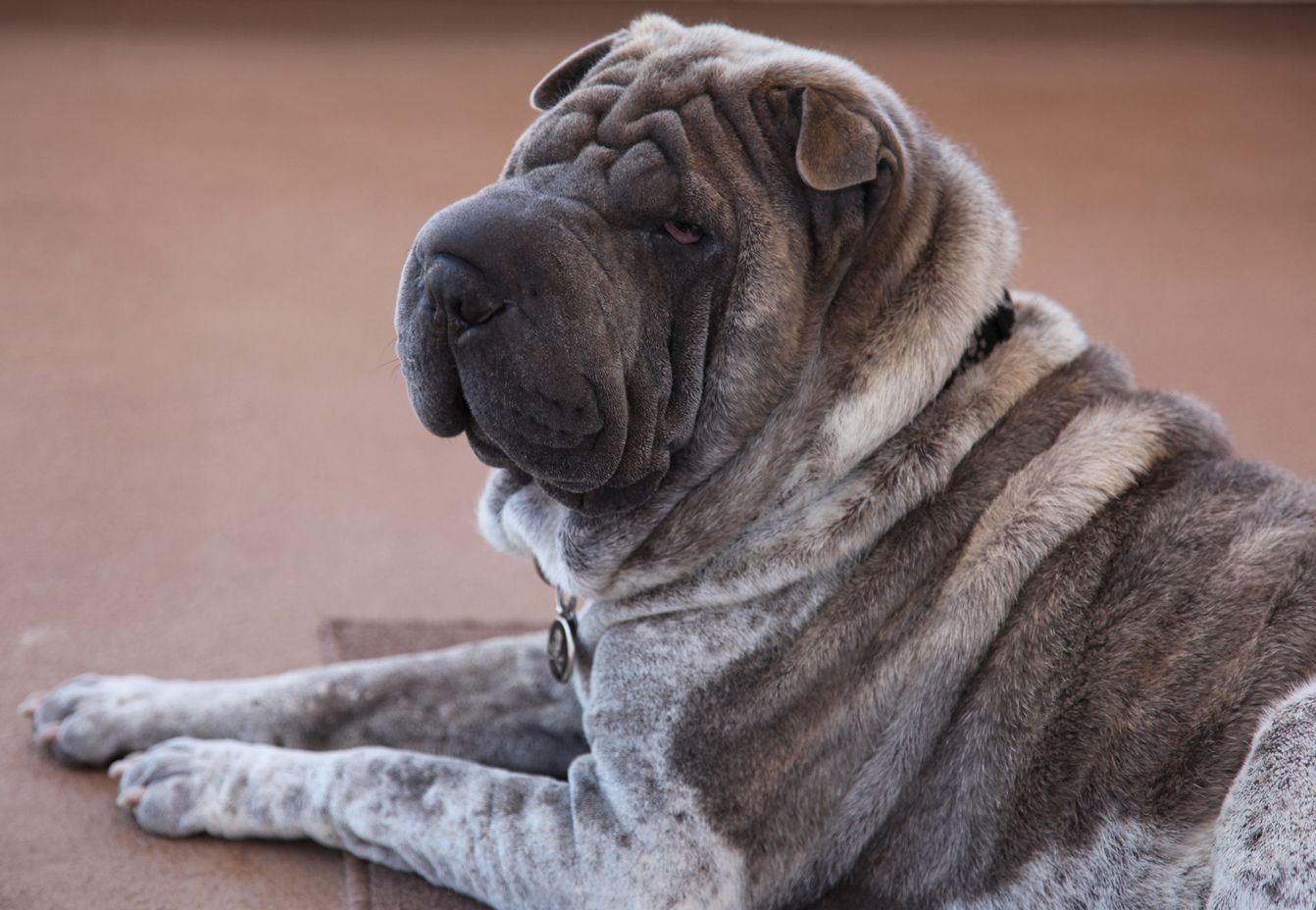
The skin is unique, hypertrophied and folded. Sharpeys have an unusual coat; it is stiff, short, and sticks out on the body. The hair is bristly without an undercoat. Representatives of the breed differ in the type of coat:
- Brush
- “Bear hair”
- Horses.
Two types of colors are allowed:
- Basic color with black pigment of varying intensity: fawn, black, sable, mahogany, isabella, blue, cream.
- Dilute group (except for black): isabella, chocolate, apricot, sable, cream, red, mauve.

Sharpei’s character
From the first days of the puppy’s stay in the house, the owner must show him who is the boss. The owner in the eyes of the pet looks like a leader, a ringleader, only under this condition will the dog obey. The Shar Pei is friendly to other family members, but it is reluctant to obey commands, obeying only the owner. It is very difficult to cope with the dominant nature of the Chinese breed. The owner must be strong, strong-willed, and have experience with dogs.
The Shar Pei is characterized by trained calmness and balance with a certain amount of isolation. The dog tends to be independent and self-reliant, will never impose its company, and at the same time does not tolerate fussiness and conservatism. A Shar Pei dog is, first and foremost, a guardian of his family. With their loved ones, they are incredibly open and sociable, characterized by great friendliness and kindness.
He loves to be alone and think about something important in life. He loves his owner and his family sincerely and boundlessly, and if he has to give his life to protect his owner, he will not hesitate to do so. These dogs have been used for many hundreds of years as bodyguards and watchmen, and therefore warriorism is in their blood.
Occasionally, it can be slightly moody, showing stoic stubbornness, but such moments are episodic.
It has warm feelings for children, especially bitches who are incredibly gentle and affectionate towards babies. Females of this breed have a pronounced maternal instinct. However, leaving them alone with unintelligent babies is strongly discouraged. It is also worth remembering that due to its physiological characteristics, the Shar Pei’s field of vision is very limited, it perceives sudden movements as a potential threat and reacts accordingly. The dog will be a good friend to older children, especially teenagers.
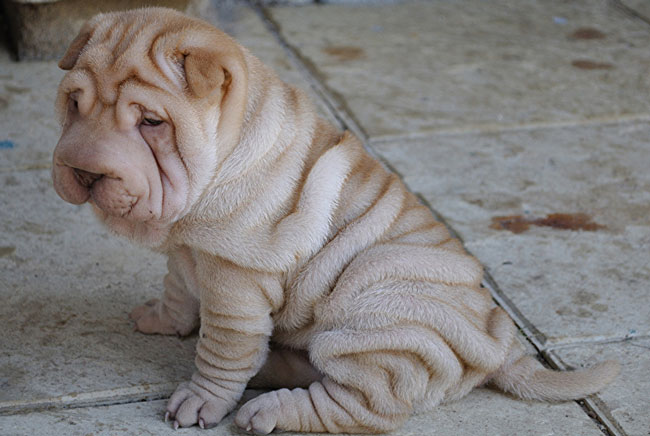
It does not get along well with other pets, unless they grew up together.
The Shar Pei sometimes emits characteristic wheezing sounds that occur during rapid breathing due to the loose structure of the nasopharynx. Other dogs perceive such sounds as growling, and accordingly begin to behave aggressively.
Sharpies are haughty and distrustful of strangers, but without aggression, they can be a good guard if necessary.
An interesting fact is that “Sharpei” means “sand dog”. When stroking the coat, you get the feeling of grains of sand rolling in your hands.
Sharpei puppies
It is worth noting that newborn Sharpeys do not have wrinkles at all, but by the 6th week of life they accumulate so many that they look like the rubber man Bibendum, a recognizable symbol of one of the car tire manufacturers. As dogs grow older, they seem to “grow out” of their skin, and only the head and withers remain covered with large wrinkles. To understand how strongly the folds will be expressed in the future pet and what type of coat it will have, you need to look at its parents.
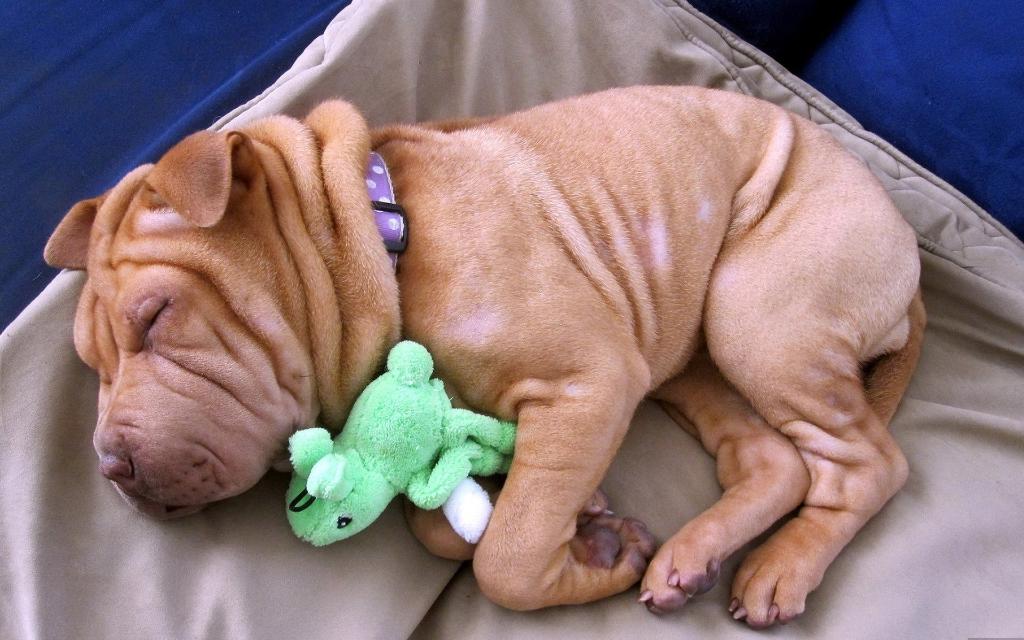
How to choose a puppy
When choosing a puppy, consider important criteria that will help you buy a pet with good health and excellent breed qualities:
- It is not recommended to take a baby from parents who have health problems or if there is a puppy with breed abnormalities in the offspring.
- The chosen puppy should be well-groomed, well-fed, and strong.
- The skin is clean and the folds are neat, the eyes, ears and nose are in perfect condition without any discharge.
- Preference should be given to an inquisitive, playful, and active puppy that is willing to make contact and does not show fearfulness or hostility.
- It is advisable to take a puppy that is already 2 months old.
- Pedigree, age-related vaccinations, metrics, and a veterinary passport are required.
An important indicator is the conditions of the mother and puppies. A dark, cramped, unprotected from the wind, and even more so a dirty enclosure does not speak in favor of the bird. Proper nutrition in the womb and in the first months of life lays the foundation for life, be sure to pay attention to the contents of the bowls!
If the Sharpeys of the chosen cattery do not participate in exhibitions at all, this is an alarm bell – they have problems either with health and physical indicators or with behavior. It is better to refuse to purchase a pet in such a place.
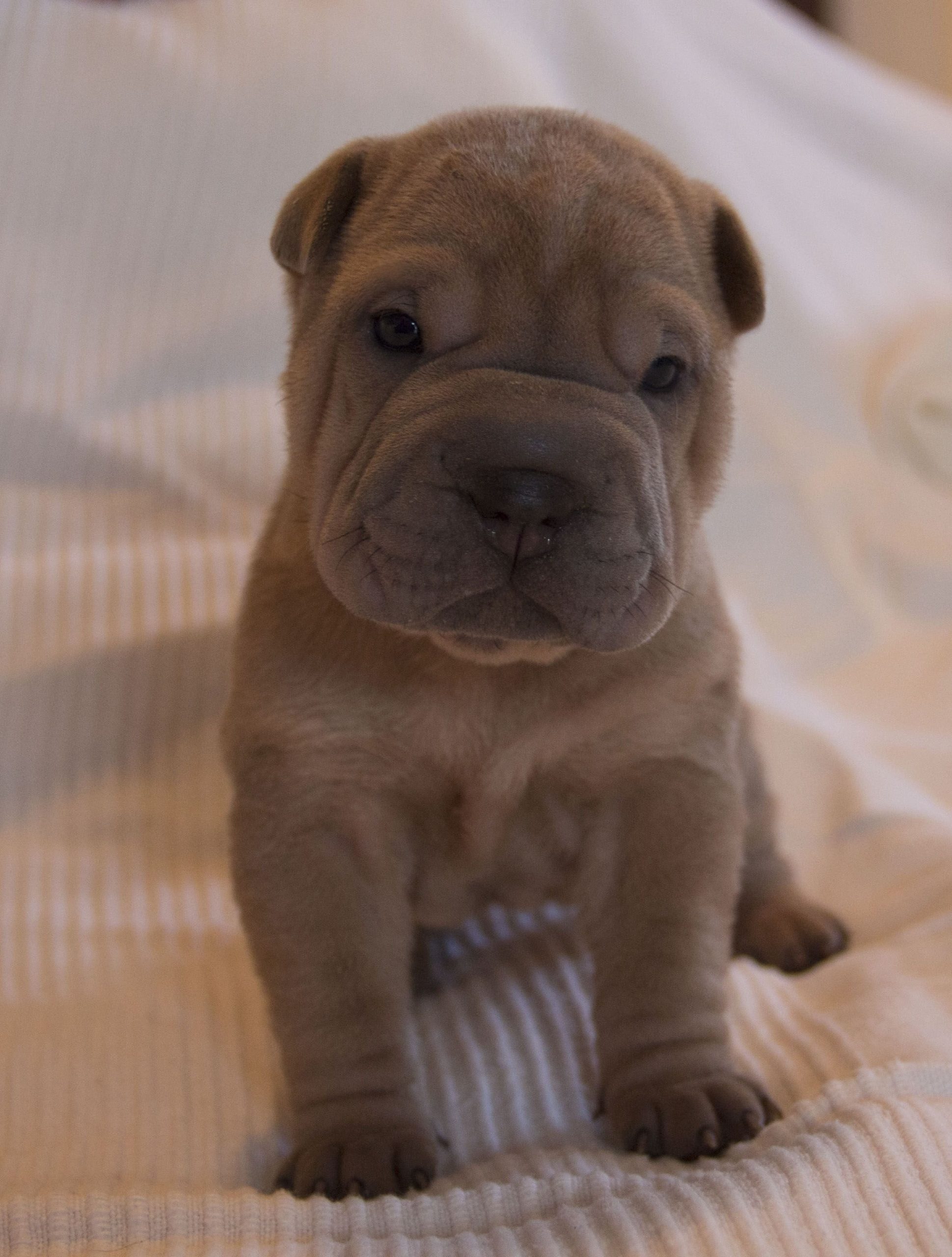
An interesting fact is that Sharpei’s coat is a very strong allergen, so before buying a dog, you need to exclude the tendency to allergies in family members.
How much does a Sharpei cost?
The lowest price for Sharpeys is traditionally offered at bird markets and online sites with free ads. Of course, in this case, you have no guarantees of breed purity, dog health, and mental stability.
Pet-class puppies, i.e. pets with purebred parents who do not fully meet the breed standard due to minor appearance flaws and do not receive a formalized pedigree, cost from $100 and up.
For breed-class Shar-Pei, which have all the breed characteristics and may be interesting for further breeding, new owners will have to pay at least $300-350.
The most expensive are show-class dogs, they not only fully meet the standard, but also have a character suitable for exhibitions, a special ability to present themselves. The potential of a champion cannot be determined at an early age, so if you hear categorical statements about such prospects for a baby of 8-10 weeks, do not doubt the seller’s dishonesty. A real breeder knows that you can only ask $600-700 for a teenager (8-9 months old) who already has experience in junior shows.
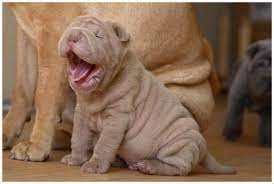
The first heat in a bitch occurs at 8-12 months of age, lasting 18-21 days. It is not advisable to breed the pet at such an early age.
Usually, the first mating is planned after the dog reaches 20 months of age, allowing the body to fully develop, thus avoiding joint problems and other diseases.
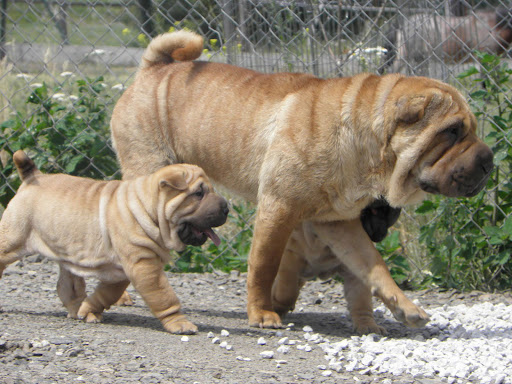
Basic rules of mating:
- Dogs are bred no earlier than 1.5-2 years of age, or even later.
- Sick animals or those with disqualifying deviations in appearance are not allowed to mate.
- A boy may be allowed to be inseminated monthly.
- A girl is mated no more than once a year.
- 2 weeks before the planned mating, visit a veterinarian to exclude possible diseases in the bitch.
- Treat for worming and external parasites.
- Find a suitable dog through kennels or trusted breeders.
- Sign a written mating agreement with the owner of the boy.
- Discuss the payment option and other nuances.

On the day of mating:
Good days for mating are 10-15 days from the day the female shows signs of sexual desire.
The dog’s owner should prepare a separate room or enclosure in advance. The female is taken to the boy’s territory, allowing the pets to get acquainted and play. After preliminary sniffing and playing, the dog makes a cage.Animals can stay in the castle from 10 minutes to several hours. Do not forcefully separate the pets, they will separate on their own.
The control mating is carried out in 48 hours. Pregnancy lasts 56-63 days, with 3-4 puppies in the litter.
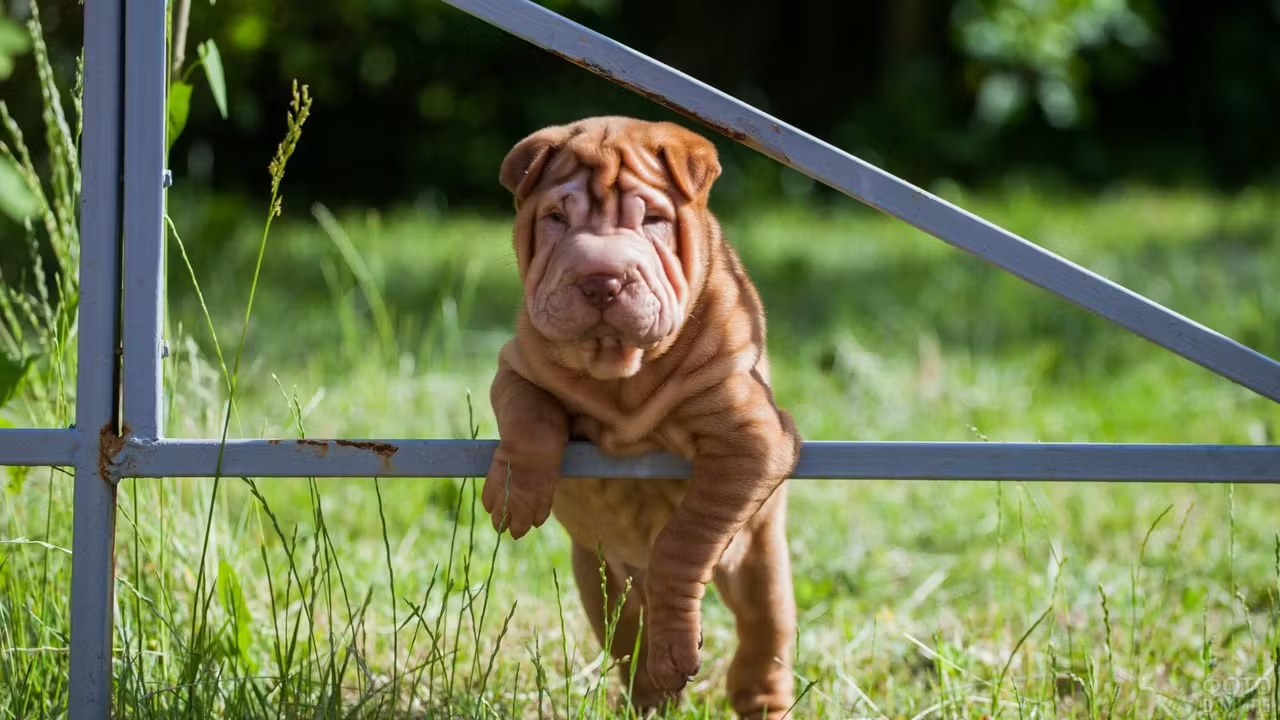
Content and care
The breed is suitable for keeping in an apartment and a country house, but in the latter case not outdoors but in a heated room. The breed does not have an undercoat, so in cold weather the pet quickly gets cold, and in hot weather it can get overheated.
These dogs do not need expensive professional grooming or frequent bathing. It should be noted, however, that during bathing procedures (once every 2-3 months, if nothing extraordinary happens), it is mandatory to use special shampoos that do not cause irritation and thoroughly dry with a hairdryer. In short-haired individuals, even seasonal shedding is almost imperceptible; it is enough to iron them once a week with a combing mitt purchased at a pet store, while pets with “bear fur” need more careful care twice a year with rubber brushes.
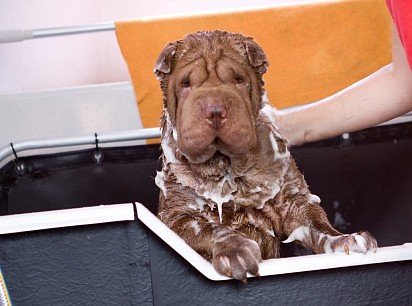
What you need to do regularly and diligently is to take care of your skin. Sweat and fatty secretions, dirt, and food particles accumulate in its folds, which can lead to dermatitis. Attention should also be paid to the ears to avoid inflammatory processes in the shells and ear canal.
An hour of walking a day is enough for Sharpeys to maintain their normal physical shape. The structure of their skulls makes them similar to brachycephalic dogs (bulldogs, boxers, pugs), so intense exercise such as jogging and obstacle courses are contraindicated due to breathing problems.
Regular brushing of teeth, the procedure prevents the appearance of tartar and promotes clean breathing. Wipe the eyes 2-3 times a week.
Claws should be trimmed as they grow.
An interesting fact is that in winter the pet does not wear insulated clothing; despite the lack of undercoat, it can withstand 2 hours outside quite well.
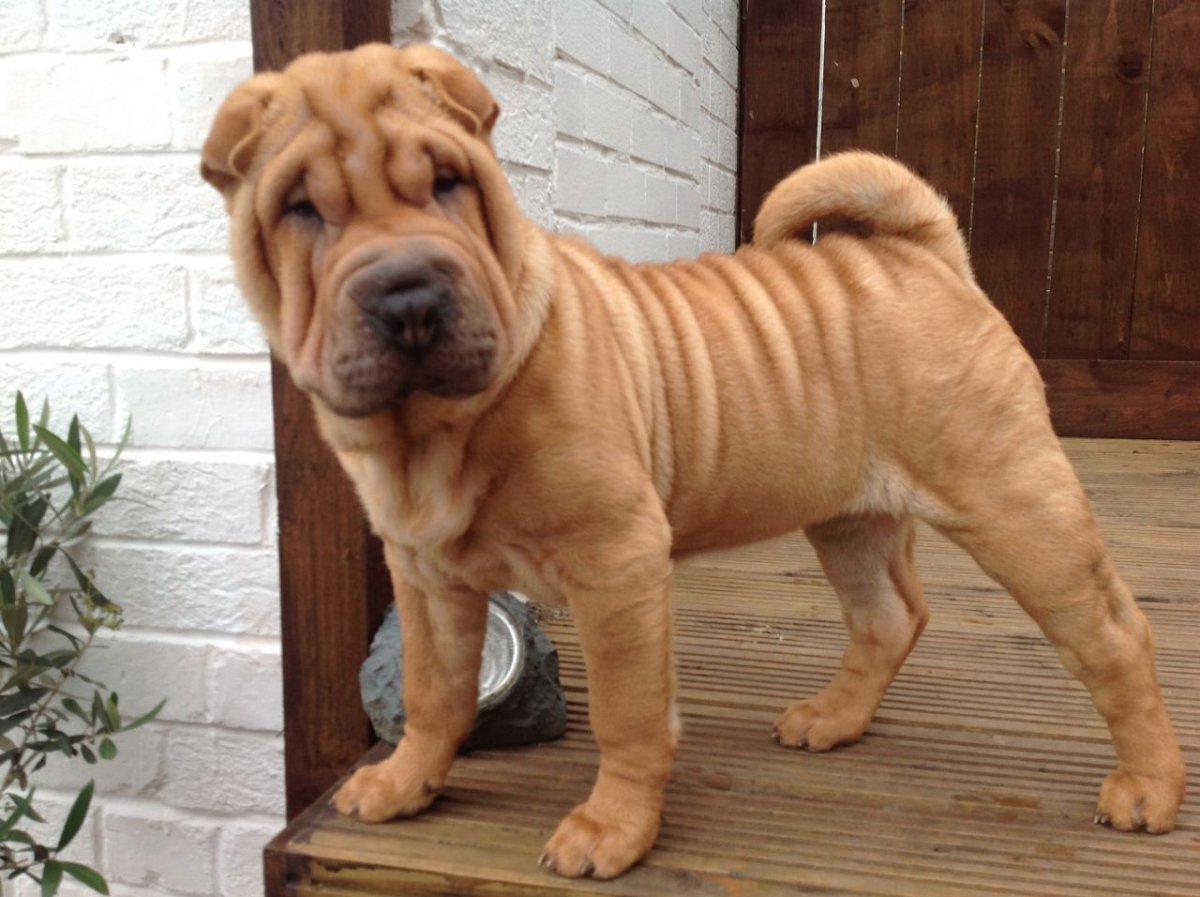
Training and education
The Shar Pei is considered a stubborn breed, so you should start training and education as early as possible. For the most part, puppies are easy to train, picking up commands on the fly and following them with pleasure. It is enough to master basic commands that will make both the owner and the pet feel comfortable.
Important points:
- From the first day the puppy appears in the house, clearly define the boundaries of what is permissible, and in no case indulge the whims of the “teddy bear”.
- Early socialization of the baby helps to avoid future aggression towards other animals and strangers. The general training course begins at the age of three months.
- Relationships with the dog should be built in such a way that the puppy perceives the owner as a leader who must be obeyed without question.
- In no case should you go along with your pet, it is almost impossible to restore discipline after a moment of weakness. The educational process requires firmness and patience from the owner.
- If the dog does not respond to commands or other requests, the disobedience is not related to the problem of mutual understanding, the reason lies in the animal’s desire to dominate the person. Do not beat or psychologically punish the puppy.
- For each diligently executed command, reward with affection and treats (pieces of hard cheese).
Food.
Natural food and industrial food of Premium or Super Premium class and holistic are suitable for Sharpei.
The pet’s diet should be balanced and enriched with all the necessary vitamins and substances that the dog’s body needs. The breed is prone to rapid growth, so at 6-7 months of age, the puppy looks like an adult.
When feeding naturally, take into account the breed’s tendency to food allergies and stomach weakness, so food should be selected carefully.
Allowed foods:
- Meat of lean varieties (beef and veal).
- Offal.
- Small-boned sea fish.
- Eggs (1-2 times a week).
- Cereals (rice, buckwheat).
- Sour-milk products.
- Cheese.
- Non-acidic fruits.
- Fresh herbs.
- Fresh and stewed vegetables.
- Vitamin and mineral supplements.
Harmful foods:
- All varieties of fatty meat.
- River fish.
- Sweets.
- Smoked meats.
- Pickles.
- Flour products.
- Chocolate.
An interesting fact is that an adult pet should eat 1 kg of food per day or 3.5% of its body weight.
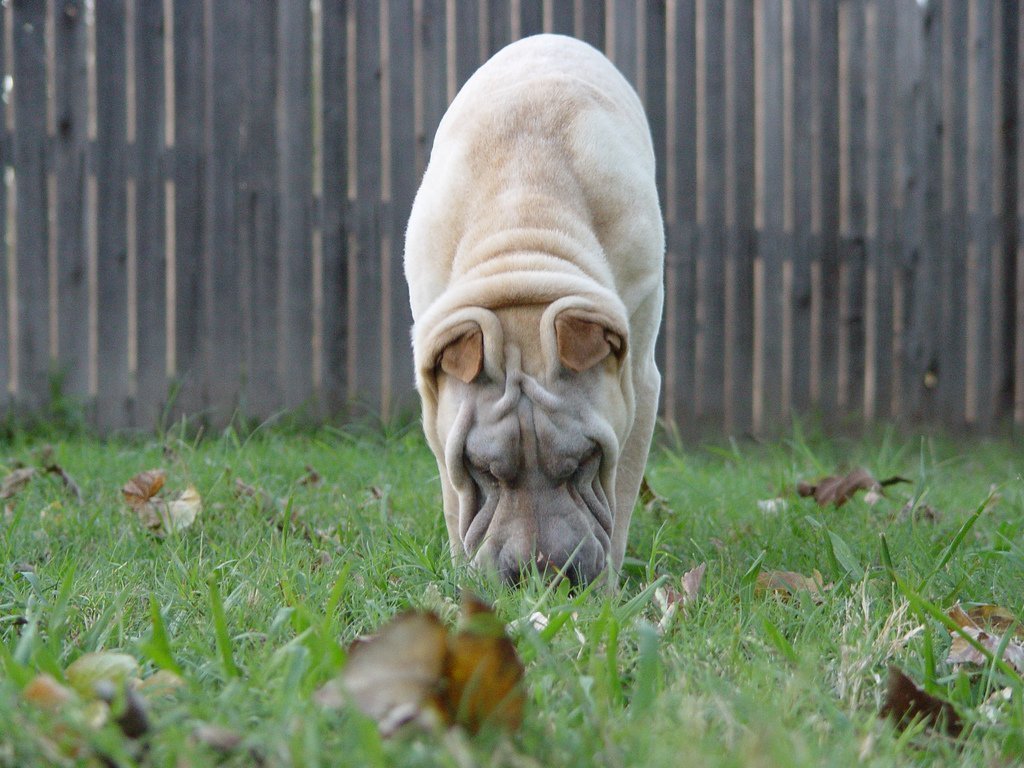
Feeding a Sharpei is not an easy task. There are many features that must be taken into account:
- If the appetite is good, you need to make sure that the pet does not overeat. Overfeeding the Sharpei will turn it into a lazy, apathetic animal. Also, if you are overweight, the kidneys will suffer.
- If your pet has a poor appetite and refuses to eat, try walking with it more and increasing physical activity. This will help improve appetite.
- In case of categorical refusal of food, change it. You need to change the diet very carefully, as the Sharpei is quite sensitive to the composition of the food. Representatives of the breed are also prone to food allergies. Therefore, it is not recommended to change the food system frequently, but if you have to do so, carefully monitor the dog’s reaction to certain foods.
- Adult dogs should be fed 2 times a day.
- Up to 1.5 years of age, feed dry food, which contains all the supplements necessary for normal life.
- After 1.5 years, the Shar Pei’s appetite deteriorates significantly. During this period, it is recommended to switch the dog to a natural way of feeding.
- Food in liquid form (soup, broth, etc.) is prohibited. Food should be thick or dry. The basis of the diet is meat and offal. Cereals, vegetables (potatoes are excluded), and fruits are added. Low-fat kefir, eggs, and fish are recommended as a treat.
- Sausages, legumes, spices, and sweets are strictly prohibited.
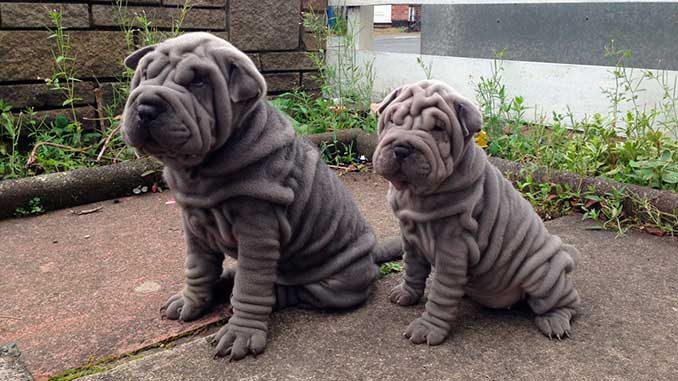
Health and diseases
The Shar Pei’s health is poor, but with proper nutrition, care, and timely vaccinations, many problems can be avoided.
Mostly, ophthalmic, ear, skin, and infectious pathologies are diagnosed in dogs:
- Hypothyroidism. It manifests itself against the background of a deficiency of certain thyroid hormones, which provokes the development of epilepsy, alopecia (hair loss), obesity, hyperpigmentation, pyoderma (purulent skin inflammation) and other dermatological problems, and in especially severe cases – lethargy. It is treated with medication and diet
- Demodicosis. It is caused by a mite and manifests itself in the form of redness and peeling of the skin.
- Sharpey fever. It is a hereditary disease, usually manifested after 1.5 years of age. There is no effective treatment method, symptomatic treatment is indicated. Sharpey fever (also known as swollen hock syndrome) manifests itself in swelling of the hock joint or even two against the background of an unexplained increase in temperature to 39-42 °C, accompanied by abdominal pain, vomiting, and diarrhea.
- Dysplasia of the TJ and elbow joint. A hereditary pathology that leads to improper formation of the joints and a decrease in their functionality.
- Pyoderma. An infection caused by bacteria, the formation of purulent fluid in the superficial layers of the epidermis and hair follicles.
- Glaucoma. It is provoked by high intraocular pressure, there is a risk of complete vision loss.
- Cutaneous mucinosis. Excessive production of mucin substance by skin cells, which leads to blisters with mucus on the epithelium. Corticosteroid drugs are prescribed.
- Dislocation of the kneecap (patella) is a congenital or acquired displacement of the kneecap relative to the normal position, which is episodic or permanent. In severe cases, it is almost impossible to insert it into the femoral block, and the animal loses the ability to lean on the affected limb.
- Osteochondrosis is an abnormal growth of cartilage in the bag, which causes painful stiffness of the joint.
- Gastric distention is a dangerous condition associated with stretching of the stomach by air that has entered as a result of too fast absorption of a large amount of food. It leads to a disruption of normal blood flow and a sharp drop in blood pressure. Immediate veterinary care is required! Alarming symptoms include restless behavior, bloating, excessive salivation, and fruitless vomiting.
- Entropion is a malposition of the eyelids, in which the free edge of the lower (rarely the upper) eyelid is wrapped around the eyeball and constantly injures its surface, causing corneal inflammation and vision loss.
After the age of four, your pet should be examined annually by a veterinarian, undergo a urine test and a biochemical blood test to detect the disease at an early stage.
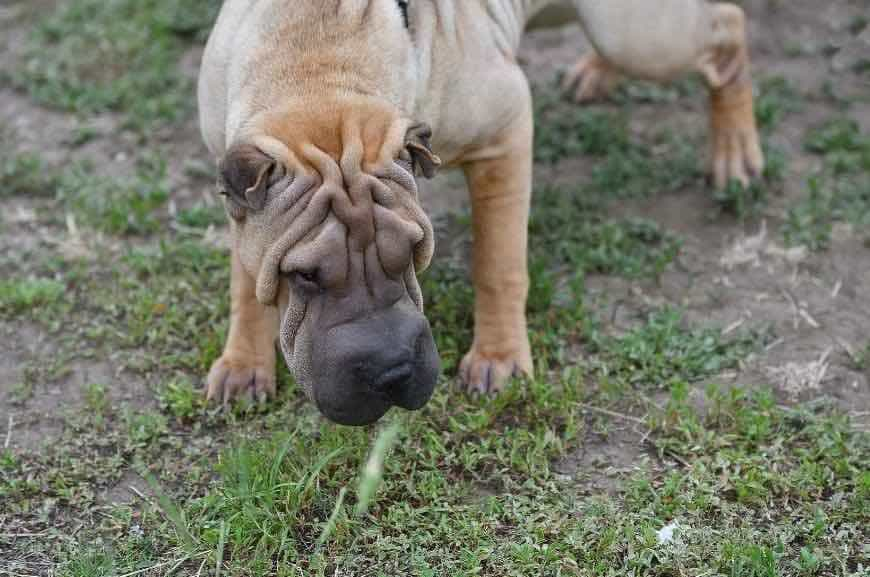
Vaccination schedule:
- 6 weeks. Deworming procedure for all puppies in the litter together with the bitch.
- 8 weeks. Repeated deworming and the first complex vaccine against enteritis, hepatitis and Carré syndrome.
- 12 weeks. Repeated vaccination of complex action.
- 14 weeks. Vaccination against rabies is done.
- 7-12 months. The last revaccination of the complex drug in puppyhood with subsequent annual repetition, combining with rabies serum.
During vaccination measures, it is necessary:
- Quarantine must be observed before and after the first vaccination.
- Until the second complex vaccination, it is not allowed to go outside or communicate with other animals.
If side effects lasting more than a day appear in the puppy after taking anti-worm medication or administering the vaccine, you should contact a veterinarian.

Pros and cons of the breed
Like any other type of animal, the Shar Pei has its own disadvantages and advantages, which every owner of such a dog and everyone who plans to buy a puppy of this breed should be aware of:
Pros:
- Neat, tidy.
- Does not have an unpleasant odor.
- Does not have the habit of spoiling furniture and things in the house.
- Has protective qualities.
- Loyal and friendly to the household.
- Not noisy.
- Not annoying.
Cons:
- Prone to many diseases.
- Aggressive towards other animals.
- Desire for dominance.
- Requires a special approach to nutrition.
- Difficulties in caring for ears and skin folds.
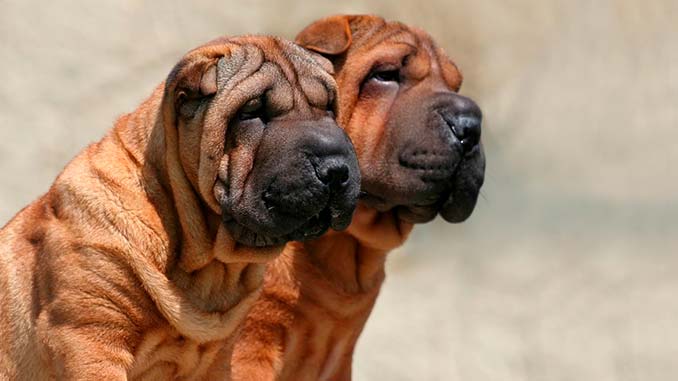
The Sharрei needs an experienced owner with a strong character who can build the right relationship with the pet. The breed is not suitable for novice dog owners and workaholics, as well as people with an active lifestyle.


